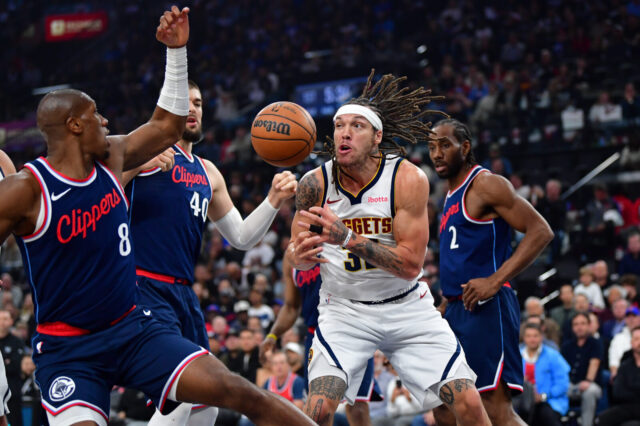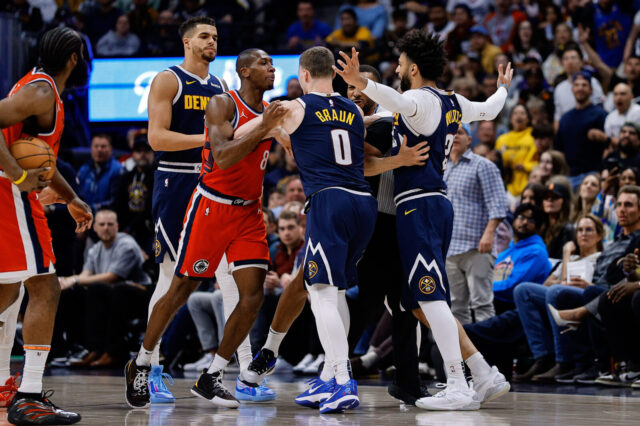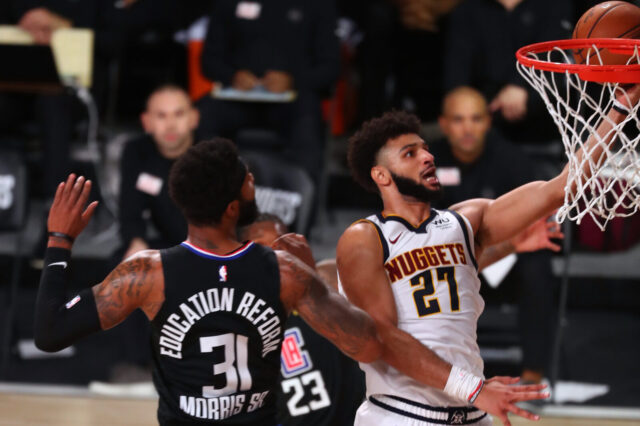Lately, there has been public discussion that the 2019-20 NBA season deserves an asterisk. No matter who wins the championship if the season does return, no matter what the circumstances end up becoming. So much about this particular season has departed from expectation.
Starting in the 2018-19 NBA Finals, Kevin Durant and Klay Thompson experienced season-ending injuries that prevented them from playing a single minute during 2019-20 (in addition, many fans don’t give full credit to the Toronto Raptors for winning last season’s Finals due to the same circumstances). Those two injuries crippled the Golden State Warriors this year, opening the door for several other organizations to stake their claim as the new juggernaut.
The Milwaukee Bucks, on pace to win 67 games, did their very best to claim that title, but the Los Angeles Lakers and Los Angeles Clippers received the most public attention due to their shiny new additions. LeBron James and Anthony Davis teamed up for the Lakers. Kawhi Leonard and Paul George teamed up for the Clippers. The aforementioned Durant and Kyrie Irving teamed up for the Brooklyn Nets for some reason. Even the Houston Rockets changed things up to pair Russell Westbrook with James Harden.
The amount of player movement left the NBA world spinning, and all the awhile, the Denver Nuggets brought back the same basic group they had in 2018-19. Flying largely under the radar, the Nuggets, despite some bumps in the road, were a slightly better team than the previous season from a quality perspective. The addition of Jerami Grant to the rotation took time to iron out, and exciting rookie Michael Porter Jr. was never fully integrated, but the rest of Denver’s roster was as solid as ever.
Before the outbreak of COVID-19 stopped the sports world in its tracks, the Nuggets were about to learn just how good they could be. While the Nuggets were on pace for 54 wins, the pecking order in the Western Conference had become more clearly defined, with the Lakers and Clippers vying for legitimate championship hopes and the Nuggets joining the Rockets, Utah Jazza, and Dallas Mavericks just hoping to get lucky with a Conference Finals berth. Could the Nuggets have won a title or at least reached the NBA Finals? It was possible but appeared unlikely heading into March.
Now, as we close the door on May, and the NBA appears to be inching closer to a return, it’s time to revisit the 2019-20 season. From where the Nuggets ended up to where they were going, here’s what we will officially learn about the Nuggets when their 2019-20 season resumes.
This content is no longer available.
How much can Michael Malone trust Michael Porter Jr.?
January was a magical month for the Nuggets for a number of reasons, but chief among them was the emergence of Michael Porter Jr. as a key cog in the rotation. In the 15 games Porter played during January, he averaged 21.3 minutes, 12.3 points, 6.9 rebounds, and 1.3 assists while shooting 52.2% from the field and 48.0% from three-point range. He showcased a lethal and versatile scoring profile, hitting difficult shots with regularity and turning several difficult shots into easy ones due to his physical profile and body control.
Porter was hitting shots like the one above with regularity before badly turning an ankle against the Milwaukee Bucks on January 31st. He sat out the remaining six games before the All-Star break, but after that game, his spot in the rotation just wasn’t the same. He exceeded 16 minutes in only two of the 10 games after the All-Star break (coincidentally scoring double digits in both of those games) and simply didn’t have the rhythm to play well or the trust of Michael Malone to let him play himself back into game shape.
If the season were to begin against today on Monday, May 25th, Porter will have all but certainly had enough time to get fully healthy. That means that the decision to play the rookie significant time would largely come down to two factors: Porter’s mental engagement and Malone’s willingness to trust him. Those factors likely go hand in hand.
Porter proved what he could do when healthy and playing regularly this season, but the playoffs are a different animal, as the Nuggets learned last season. Opposing teams pick on the biggest weaknesses they can find to garner the biggest advantage, and Porter’s defense, albeit coming along with time, will be the first thing teams try to take advantage of when Porter steps on the floor. What made last year great for the Nuggets was they were able to discover the level of talent they had with Jamal Murray and Nikola Jokic because Malone trusted them in the face of mistakes and gaffes. Murray’s 21-point fourth quarter in Game 2 against the San Antonio Spurs doesn’t happen if Malone had (justifiably) removed him after a horrendous first three quarters of that game.
Young players will make mistakes, but as Denver learned previously, talent and poise ultimately win out. Jokic and Murray earned their stripes in last season’s playoffs. Does Porter get the opportunity to do the same?
This content is no longer available.
What level of issue is Denver’s size on the wing?
For several years of Nuggets basketball, the most dreaded position to stop has been opposing small forwards. For years, Durant and LeBron James destroyed everyone the Nuggets could throw in their path, and even though Durant left for Brooklyn, he has been replaced by Kawhi Leonard (6’7), Paul George (6’8), and Luka Doncic (6’7) as big scoring and playmaking forwards that offer mismatches all over the floor.
The Nuggets this season started Gary Harris (6’4 on a good day) and Will Barton (6’5, 181 pounds), both of whom are good defenders but struggle when overpowered by players who fit the above size profile. Torrey Craig (6’7) fits the profile but struggles to help keep the offense humming while he’s out there. Michael Porter Jr. (6’10) makes sense physically but still has a ton to learn on that end and probably doesn’t have the fluidity necessary to keep up with those top options. Jerami Grant (6’9) makes the most sense athletically but plays exclusively power forward, so the Nuggets would have to change things up in order to maximize him guarding small forwards.
Ultimately, the Nuggets are likely in trouble here, and they were likely in trouble from the start. The teams with the most competent and healthy wings have generally won in the playoffs the last few years. Any team that features LeBron, Kawhi, or KD will likely do that. Finding a player or scheme to combat those types of players is one of the most important steps to becoming a champion, and the Nuggets, though they have several players who can defend other positions, likely don’t have a great option on their roster to defend top wing talent. The best option (in my opinion) is Grant, but he’s stuck on the bench behind Paul Millsap and doesn’t have the positional flexibility to defend small forwards unless another player can defend power forwards another reason I like the Porter-Grant combination long term).
The Nuggets didn’t have to defend players quite like LeBron, Kawhi, PG, and Luka in last year’s playoffs. They faced different challenges defending teams with elite guards, but they were more well-prepared for those situations against the San Antonio Spurs with DeMar DeRozan and the Portland Trail Blazers with Damian Lillard and CJ McCollum. Denver’s downfall in that Portland series was Rodney Hood, a 6’8 wing who averaged 14.7 points on 57% shooting in the seven-game series.
If the Nuggets cannot find ways to defend wings in the playoffs this year, there will be changes to the roster and starting lineup going forward. Denver can’t wait to find out in a year unaffected by COVID-19 to address what appears to be their biggest deterrent as a championship contender.
This content is no longer available.
Does Jamal Murray have another gear?
In the 15 games Murray played since returning from a sprained ankle, he looked like a different, more aggressive version of himself. He averaged 21.9 points and 5.5 assists per game while shooting 50.4% from the field and 39.0% from three on seven attempts per game. He also had a six-game streak of 20+ points, which was the longest such stretch of his NBA career. There were some subpar performances sprinkled in, but overall, it was the most consistent stretch of star caliber basketball in Murray’s four-year career.
The season numbers were underwhelming though. He made some strides as a scorer inside the arc, but his three-point percentage went down and his per game numbers appeared largely the same. That stagnation left Murray’s ultimate ceiling up for debate. Can he still reach a new level and play like a Damian Lillard or Stephen Curry type point guard for a prolonged period of time? Or, is he destined to be a “good, not great” point guard who earned a max contract too soon?
There are arguments for both sides, but it’s good to remember that Murray is still 23 years old. It took a long time for Murray to iron out some of the intricacies of point guard play, but he seemed to have figured some stuff out before COVID-19 put the season on hold. In addition, Murray attempted at least eight three pointers 12 total times this year, and seven of those came in that final 15-game stretch I discussed above. He attempted fewer than five three-pointers just twice, and he appeared more confident as a shooter than ever before.
That three-point shot could be the difference between Murray becoming a good or great point guard. The defining characteristics of point guards today is their ability operate as a perimeter playmaker for others and scorer for themselves. Seven guards this season averaged 20 points and five assists while exceeding 35% from three-point range: James Harden, Damian Lillard, Bradley Beal, Kyrie Irving, Trae Young, Devin Booker, and D’Angelo Russell. Murray was at 18.8 points, 4.8 assists, an 34.5% from three, so he wasn’t that far off in any category. Taking that production and efficiency to these new heights entering the postseason this year would be one way for Murray to prominently showcase his abilities and justify his contract.
Murray making this leap would also solve some looming problems facing the Nuggets going forward. With Jokic and Murray locked into max contracts for the foreseeable future, there are few avenues for the Nuggets to get significantly better outside of making a trade. One of those avenues is Michael Porter Jr. making a leap. Another is Jamal Murray growing into his role as de facto second option with the ability to win playoff games for the Nuggets on any given night. Murray proved he could at least match up with Lillard and McCollum in the playoffs last year. Proving himself again in the playoffs this year would go a long way and give the Nuggets added confidence to let Murray develop rather than making a shortsighted trade.
If the playoffs do end up happening, the Nuggets will need to be ready. Everything will be very weird, but in the end, it’s still basketball. The above questions are perhaps the three most important for Denver’s title hopes in the short and long term. There is a lot of pressure on Porter Jr. to be impactful in bizarre circumstances. There’s a lot of pressure on Harris and Barton defensively to match up with the likes of James, Leonard, George, Doncic, and James Harden and limit those superstars enough for Denver to win a playoff series.
But the most pressure is on Murray. He wanted to be one of the greats, and it’s nearly time to hold him to the highest standard. If he wants to be an elite scorer and playmaker in this league, the playoffs are the best stage to prove his chops and justify Denver’s belief in him as a player.
Can the Nuggets handle it? We are about to find out.


